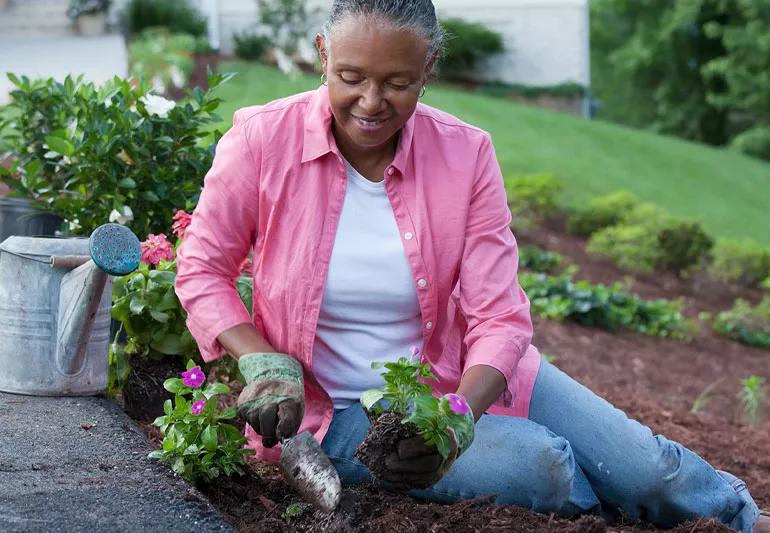Specialist Gardening Tips for Creating a Sustainable and Eco-Friendly Yard
Embarking on the trip to develop a environmentally friendly and lasting garden involves a collection of calculated options and techniques that not only enhance the charm of your room yet also add favorably to the atmosphere. By picking native plants that are appropriate to your region, you can lower dependence on chemical fertilizers and chemicals while giving essential assistance to regional wild animals. Furthermore, incorporating water preservation strategies and organic horticulture approaches plays an important role in keeping a healthy and balanced ecosystem. To reveal even more sensible approaches and skilled understandings, allow us check out the crucial elements that specify an ecologically mindful garden.
Choose Native Plants
Choosing native plants for your yard is a basic step towards attaining sustainability. In addition, native plants typically call for less water as soon as established, adding to a lot more reliable water usage.
Beyond their useful benefits, indigenous plants play a crucial role in sustaining neighborhood biodiversity. They give crucial habitat and food resources for native wild animals, including pollinators such as butterflies, birds, and . This cultivates a balanced ecosystem, which is important for the wellness of your garden and the surrounding setting.

Implement Water Preservation
Applying water preservation methods is essential for preserving a lasting yard. Effective water usage not only reduces the ecological effect but likewise makes certain that plants receive sufficient hydration without wastage.
In enhancement, mulching is an important method for conserving water. By applying a layer of organic compost, such as timber chips or straw, around the base of plants, garden enthusiasts can reduce dirt dissipation and preserve constant wetness degrees. Compost additionally aids manage soil temperature level and reduces weed growth, additional adding to plant wellness.
Rainwater harvesting is an additional lasting approach. Installing rainfall barrels or other collection systems enables garden enthusiasts to catch and store rain, which can later on be utilized throughout dry durations. This not just conserves municipal water yet also provides a natural, chemical-free resource for irrigation.
Lastly, choosing drought-tolerant plant species can drastically reduce water demands. These plants are adapted to prosper in low-water conditions, making them perfect for eco-friendly yards. gardening tips. Executing these water preservation techniques will certainly foster a resistant, sustainable yard
Usage Organic Gardening Approaches

Pest monitoring in a natural yard relies upon incorporated bug administration (IPM) methods. These consist of encouraging helpful pests, utilizing natural predators like ladybugs and lacewings, and carrying out crop rotation to disrupt pest life process. Friend planting, where certain plants are grown with each other to fend off bugs or draw in useful bugs, is one more reliable method.
Weed control is taken care of with mulching and hand-operated removal, rather than relying upon herbicides. Mulch not only suppresses weeds but additionally saves moisture and boosts dirt health and wellness as it breaks down. Organic composts, such as straw, wood chips, and leaves, are especially useful.
Create Wild Animals Habitats
Creating wild animals habitats within your yard not only boosts biodiversity yet likewise supports the ecosystem's equilibrium. By developing rooms that draw in and sustain regional fauna, you can develop a flourishing micro-ecosystem that profits both animals and plants. Beginning by integrating indigenous plants, as these are appropriate to your neighborhood climate and provide necessary food and shelter for wildlife. Indigenous flora supports a variety of bugs, birds, and tiny animals, adding to the ecological network.
Think about including a water feature, such as a pond or birdbath, to supply a regular water source. Water aspects bring in a selection of species, from amphibians to pollinators, improving the yard's vigor. In addition, installing birdhouses, bat boxes, and insect hotels uses secure nesting websites and encourages biodiversity.
Leave some areas of your garden undisturbed, enabling ground cover and fallen branches to accumulate. These natural debris stacks develop habitats for pests and small animals, fostering a balanced community. Stay clear of utilizing chemical pesticides and herbicides, as they can damage advantageous wildlife and interrupt food cycle. By focusing on these lasting methods, your yard can end up being a shelter for regional wild animals, advertising environmental health and wellness and sustainability.
Practice Composting and Mulching
An essential aspect of lasting horticulture, composting and mulching, dramatically boosts dirt health and wellness and minimizes waste. Composting includes recycling natural products such as kitchen area scraps, turf clippings, and leaves. These products disintegrate to develop why not try these out nutrient-rich garden compost, which serves as a natural plant food. Unlike artificial fertilizers, garden compost enhances the soil with valuable bacteria and vital nutrients, fostering a much healthier garden ecosystem.
Mulching, on the various other hand, includes covering the dirt surface with not natural or organic materials, such as straw, wood chips, or shredded fallen leaves. This practice uses several advantages: it preserves soil wetness, subdues weed growth, and moderates soil temperature level. Mulch likewise progressively breaks down, adding organic issue to the soil and further improving its fertility.
To practice efficient composting, guarantee your garden compost heap has a balance of green materials (rich in nitrogen) and brown products (abundant in carbon), keeping appropriate oygenation and dampness. gardening tips. Frequently transforming the stack increases disintegration. For mulching, use a 2-3 check my source inch layer around plants, guaranteeing it does not straight speak to stems or trunks to prevent rot
Final Thought

Picking native plants for your yard is a fundamental action towards accomplishing sustainability.Furthermore, including native plants can boost the aesthetic charm of your yard. These plants are adapted to grow in low-water conditions, making them excellent for environment-friendly yards. Executing these water preservation methods will promote a resilient, lasting garden.
In conclusion, developing a sustainable and environmentally friendly garden involves the critical selection of native plants, the adoption of water preservation techniques, and the application of organic gardening techniques.